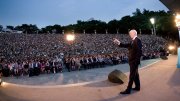Think of—to use a purposefully loaded term—an “immigrant novel.” Central to the narrative is a certain kind of character: a recent immigrant, or a child of immigrants, who moved to seek opportunity in the United States because of financial, political, or other hardship in their native country. The protagonist must navigate a new environment, such as school or work, while maintaining some level of connection to their origins. Challenges ensue; questions arise. What do they owe the people they’ve left behind? What does it mean to become an American?
Many important works of fiction have used this template to explore questions of migration and identity. But these narratives also have shortcomings, says Cabot professor of American literature Glenda Carpio. In their narrow focus on how individual immigrants adapt to their new settings—their reliance on what she calls “the acculturation plot”—such stories can obscure the political, economic, and historical forces that necessitate migration in the first place. They can also reinforce the myth of the American dream by centering immigrants who assimilate and achieve conventional success—and leaving out the stories of the many who don’t.
Moreover, Carpio argues, these narratives tend to rely on empathy as a mode of reading. There’s long been a popular belief that one should read fiction about immigrants to “walk a mile in their shoes,” as the cliché goes: to feel for them, even to feel like them. Through this experience, many readers believe, they can become “better people and, by extension, better political subjects,” she contends. But empathy can actually have the opposite effect: to “keep readers stuck in the realm of feeling,” she writes in Migrant Aesthetics: Contemporary Fiction, Global Migration, and the Limits of Empathy, “a sentimental terrain wherein feeling bad for immigrants rarely, if ever, leads to questioning one’s own assumptions and actions.”
Carpio explores the work of contemporary authors who reject the generic features of immigrant literature, such as the acculturation plot and a reliance on readers’ empathy. Through their practice of what she calls “migrant aesthetics,” these writers forge new formal and narrative methods to explore the forces beyond the individual that drive migration, such as colonialism and empire. Their works reveal “how European and American geopolitical and economic interests have shaped the entire world, forcing millions of people to migrate,” Carpio writes—from the arbitrary construction of borders by colonial powers such as Britain and France (two countries responsible for more than 40 percent of the world’s borders), to the impending impact of the climate crisis, which will drive migration from places affected by extreme weather.
Valeria Luiselli’s 2019 Lost Children Archive was among the first works of migrant fiction that drew Carpio’s attention to the contemporary writers redefining the genre. Partly inspired by the Trump administration’s family separation policy, the novel centers on the experiences of migrant children at the U.S.-Mexico border. But it is not a traditional immigration narrative. Instead, the novel follows a middle-class American wife (the narrator), husband, and their two children on a road trip from New York to Arizona.
Throughout the drive, the father tells the children myths and history about the indigenous Apache, whom he is researching, while the mother tells them about child refugees—the “lost children”—including her friend Manuela’s daughters, who went missing in federal custody after crossing the border to seek asylum. Luiselli uses formal techniques to draw connections between these various perspectives and moments in time, such as a single, twenty-page-long sentence in which she continuously switches point of view. “Reading [Lost Children Archive] is when I realized: oh, it’s about scale,” Carpio says: “[getting] away from the individual, and the neoliberal idea that the individual and looking inward is the key to political activism.”
By making connections between different moments in time—from the Americas before European conquest to the present—Lost Children Archive represents time as repetitive rather than linear, she argues. The novel thereby conveys the historical causes of migration at the U.S.-Mexico border. When people consider why migrant children risk their lives in their attempts to enter the United States, they might think of the most recent and surface-level reasons: “because their countries are riddled with gangs, or because they have unstable governments, or because they’re poor,” Carpio says. “But behind those reasons, there’s a whole history of colonialism.” Luiselli, for example, traces the origins of the gang-driven migrant crisis to American foreign policy decisions—in particular, the Reagan administration’s funding of repressive governments in Latin America.
Julie Otsuka’s novel about Japanese internment, When the Emperor Was Divine (2002), also challenges readers to listen to how seemingly distant historical moments echo in the present—how “we end up repeating catastrophe because we don’t learn from the past,” Carpio says. Although the book is set during World War II, the timing of its publication, just a year after the World Trade Center attacks, spoke to the contemporary criminalization of a different group of ethnic minorities during a time of global conflict: Muslim Americans in the wake of 9/11. Today, Carpio argues, the novel challenges readers to think of all the migrants being held in detention centers at the U.S.-Mexico border. The notion that history repeats itself is reflected in the structure of the novel: Otsuka ends chapters before they finish a narrative arc to “get us to experience time in detention, how much being constrained spatially makes time feel flattened,” Carpio says. “You end up having distorted memories and a very fuzzy future.”
Literature about migration often carries weighty responsibilities—to turn readers into better people; to carry sweeping, universal messages about shared humanity. But the authors examined in Migrant Aesthetics subvert these expectations and simply testify to migrants’ experiences, Carpio says. She believes that has “the potential to shift consciousness. Does that make you a better person, in the sense that you see the world differently because you read these books? Maybe. But are you going to do something about that? That’s a big maybe.” It’s ultimately up to the reader to decide whether to act.









